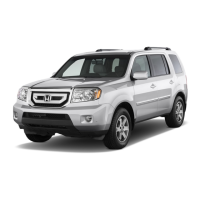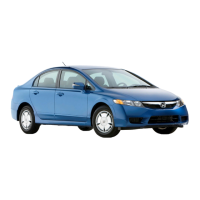
Do you have a question about the Honda 2009 Ridgeline and is the answer not in the manual?
| Brand | Honda |
|---|---|
| Model | 2009 Ridgeline |
| Category | Automobile |
| Language | English |
Overview of features designed to protect occupants during a crash, including structural elements and restraint systems.
Guidelines for properly protecting drivers, adult passengers, and teenage children in the front seat.
General guidelines for child safety, emphasizing rear seat restraint and airbag hazards.
Identifies indicators and gauges on the instrument panel that provide operational information.
Explains the system that protects the vehicle from theft by disabling the fuel system.
Explains power door locks, lock tab, master switch, and lockout prevention features.
Instructions for using the remote transmitter for locking, unlocking, panic mode, and windows.
Operation of power windows, including auto reverse and back window functions.
Information on the vehicle's heating and air conditioning system for comfortable driving in all weather.
Details on operating the automatic and semi-automatic climate control system, including voice control.
Explains how the security system protects the vehicle from theft and its automatic setting procedure.
Instructions on using cruise control for maintaining set speeds on highways.
Comprehensive guide to using the Bluetooth HandsFreeLink system for phone calls and voice commands.
Guidance on selecting the correct gasoline type, octane, and additives for optimal engine performance.
Guidelines for properly storing and securing cargo in the passenger compartment, pickup bed, and In-Bed Trunk.
Ensuring all carried items are properly stored or fastened down securely.
Ensuring the driver and all passengers have fastened their seat belts.
How to engage and disengage the VTM-4 Lock feature for stuck situations.
What the indicator means and actions to take when a tire is significantly underinflated.
How the TPMS indicator functions and its interaction with the VSA system.
What the ABS indicator signifies and actions to take if it comes on.
What the VSA activation indicator signifies and when it blinks.
How the VSA system indicator functions and when to have it inspected.
Information on vehicle and trailer load limits, including GVWR, GAWR, and GCWR.
Chart providing maximum trailer and tongue load limits based on occupant numbers.
How trailer weight affects vehicle handling and performance.
Information on types of trailer brakes (surge and electric) and installation precautions.
Tips for making turns and braking safely with a trailer attached.
How to manage crosswinds and turbulence caused by passing vehicles.
Importance of using safety chains correctly when towing a trailer.
A checklist of essential items to inspect before towing a trailer.
Guidance on special driving skills and techniques required when driving with a trailer.
Essential precautions to avoid loss of control, rollover, and cargo issues.
Steps and precautions for safely driving through water.
Procedures for getting unstuck using VTM-4, tow hooks, or calling a towing service.
Techniques for accelerating slowly and braking safely on various surfaces.
Guidance on safely navigating hills, including walking slopes and turning around if necessary.
Essential safety precautions to follow before performing any maintenance tasks.
Details on viewing and interpreting the engine oil life display.
Step-by-step guide to resetting the engine oil life display after service.
Recommendations for using Honda parts and finding qualified service.
Step-by-step instructions for changing the engine oil and filter.
Instructions for adding Honda Long-life Antifreeze/Coolant Type 2 and inspecting the system.
Guidance on draining, refilling, and checking the automatic transmission fluid level.
Importance of proper tire type, size, condition, and inflation for safe operation.
Detailed information on checking tire pressures and the effect of temperature changes.
Instructions and precautions for replacing tires and wheels, including size and TPMS compatibility.
Preparation steps for parking the vehicle for an extended period.
Troubleshooting steps when the engine does not start or the starter motor sounds weak.
Step-by-step guide and safety precautions for jump starting the vehicle's battery.
Detailed procedures for safely jump starting the vehicle's battery.
What the indicator means and immediate actions to take if oil pressure is very low.
What the indicator means and actions to take if the battery is not being charged.
What the brake system indicator signifies and actions to take if it comes on.
How to check for blown fuses and replace them using the fuse puller.
Procedures for safely towing the vehicle in an emergency situation.
Steps to take when the vehicle becomes stuck in sand, mud, or snow.
Information on TPMS requirements, including checking tires monthly and inflating to proper pressure.
What the low tire pressure telltale signifies and how to respond.
How the TPMS malfunction indicator functions and when to check replacement tires.












